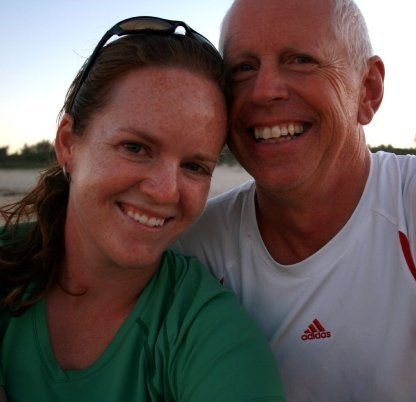






Our second dive was at a little spot called Pixie's Pinnacle, at a gap between Ribbon Reefs #9 and 10. A column of coral rises up from the sand at 100ft to just below the surface. The whole thing is covered in life, with lots of healthy hard corals, some sea fans and soft corals, tons of fish, and some little creatures we had never seen before. Large schools of little fusiliers swarmed in the water column beside the pinnacle, and a handful of trevally did their best to catch them, causing the schools to explode like fireworks each time they went for it. We spotted a black lionfish with long delicate fins, some big chunky yellow and black nudibranchs, grouper, pipefish, schools of anthias, and some big anemone patches with resident anemonefish. We spiraled up for an hour until we were low on air, then made our way back to the boat. Aside from some storm damage in the shallows thanks to the recent cyclone that ripped through here, the reefs seem to be nice and healthy, thanks to the fact that not many boats make it out this far!




Cod Hole is a site that is world famous for its resident potato cod, which are grouper that can grow up to over 300lbs. It also happens to be a beautiful site, with massive corals galore. We were running out of daylight, as one of the divers collapsed after the second dive and smashed his head open on a post when he fell, so we had to detour over to nearby Lizard Island to evacuate him out in a plane. He'll be fine, but it was just a precaution since he exhibited symptoms of an embolism, plus he had a concussion and needed stitches. So we got a view of the exclusive $1000/night resort on the beach on Lizard Island, watched the plane come and go, and then we carried on east to Cod Hole. Dive guides have been hand feeding the potato cod for decades, so we were going to see it happen too. All 27 of us jumped in the water at once and descended to a big sandy patch at about 30 feet. Even at the surface, snapper were circling the guide, who had a bucket full of sardines for the feeding. A big potato cod soon joined in the action, following the bucket all the way down to the bottom. We kneeled in the sand and watched the guide make his rounds, sneaking out a sardine now and then, which the big guys snatched up in a hurry. Their mouths must have been 18 inches wide, and when they swam by, I would guess they were about 4 or 5 feet long, with eyeballs the size of oranges! It was funny how in your face they would be, swimming right up to you and looking you in the face, hoping you had food for them, then swinging around when the sardine bucket came by, not caring if they slammed into you in the process. There were three or four of them, plus tons of snapper that swarmed around baring their vicious looking teeth, hoping to score a snack. After the feeding, we spent the other half of the dive exploring the big coral formations, ducking in between to get out of the current and find black and blue flatworms, lionfish, and the biggest friggin giant clam we had ever seen. They're usually a foot or two across, but this one was more like four feet across. Its "out hole" was at least 18 inches across! The craziest part was when you get close and they close their shell, this one reminded me of Indiana Jones since the whole entire rock creaked shut when you got close!






Night dive time! We jumped back into Cod Hole to check out the reef after dark. The reef fish were noticeably jumpy when they found themselves in the spotlight, and little nocturnal critters like tiny red and white squat lobsters and neon orange coral crabs came out to feed. Half way through the dive, I was hovering over a table coral when one of the big potato cod swam out from underneath it, scaring me half to death. He was happy to use our lights for hunting, following the beam and snagging a fish here and there as he followed along with us. After a few minutes, he caught a big snapper and then zoomed off into the dark. We thought he was gone, but a minute later three of them came bolting out of the darkness, heading straight for us. Talk about scary - three monstrous black beasts bee-lining it straight for you in the dark! They stayed with us, weaving in and out to use our lights, not even leaving us until we were all the way back at the boat.

We enjoyed brownies and ice cream while the crew video guy showed us the footage he took today, all set to music like I like to do with my videos at home. It was an awesome day - we're waterlogged already! But now we're being thrown about our cabins as we set said towards Osprey Reef, sailing overnight across the open ocean.






No comments:
Post a Comment